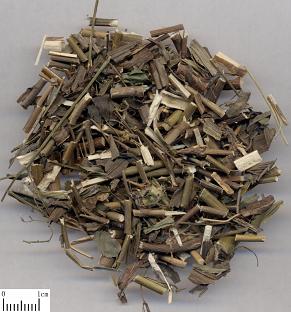Chai Hu
The Processing of Chai Hu
Origin
The root of perennial herb Bupleurum chinensis DC. or Bupleurum scorzonerifolium of family Umbelliferae. Separately named Bei Chai Hu or Nan Chai Hu.
Location
Bei Chai Hu is mainly produced in Hebei, Henan, Liaoning provinces; Nan Chai Hu is mainly produced in Hubei, Sichuan, Anhui provinces of China. Generally, Bei Chai Hu is better to be used as medicine.
Harvest
In spring and autumn.
The actual smell and taste
Slightly fragrance and slightly bitter taste.
Best quality
The wide and long with less rhizoid root.
Processing
Unprocessed or prepared with vinegar and cut into segments.
The Effect of Chai Hu
Property
Bitter, pungent, slightly cold; liver and spleen meridians entered.
Actions
Release exterior and cure fever, soothe liver and release liver depression, ascend yang qi.
Indications
A. External pathogens attack with exterior symptoms and alternating chills and fever due to shaoyang syndrome.
It has the actions of expelling the pathogens and releasing exterior, especially being effective to high fever, no matter cold or heat type due to external pathogens attack, such as the modern single or compound injection made by Chai Hu that used widely to treat fever due to external contraction. For wind-cold exterior syndrome, it is frequently combined with Qiang Huo, Jing Jie, Fang Feng and so on which have the action of expelling the wind and cold pathogens, such as the Zheng Chai Hu Yin in Jing Yue Quan Shu (Jingyue’s Complete Works), it is combined with Fang Feng and Sheng Jiang. For wind-heat exterior syndrome, it can be combined with Ge Gen, Bo He and other herbs that have the action of dispersing wind-heat or clearing heat. It is an important herb to treat the shaoyang disease with symptoms as alternating chills and fever, fullness in the rib and chest area, bitter taste in the mouth and thirsty for it's easy to go into the shaoyang meridian and effective to expel the half-exterior half-interior pathogen. Also, it is frequently combined with Huang Qin to take the effect of treating shaoyang disease by mediation, such as Xiao Chai Hu Tang in Shang Han Lun.
B. Liver depression with qi stagnation
As an important herb for treating syndrome of liver depression with qi stagnation manifested by distending pain in the rib area or abdomen, depression, irregular menstruation, etc., it is frequently combined with qi-flow-promoting and liver-soothing herbs and blood-activating and pain-relieving herbs to strengthen its effect. Just as Chai Hu Shu Gan San in Jing Yue Quan Shu, it is used together with Xiang Fu, Chuan Xiong and Bai Shao. For the treatment of liver depression and blood deficiency, and spleen failure in transportation with symptoms of irregular menstruation, distending pain in the breast, pain in the rib area, listlessness, poor appetite, wiry empty pulse, it should be combined with blood-nourishing, liver-emolliating and spleen-invigorating herbs, as Xiao Yao San in Tai Ping Hui Min He Ji Ju Fang, it is used with Dang Gui, Bai Shao, Bai Zhu, Fu Ling, etc.
C. Syndrome of sinking of middle qi
This herb can ascend the clear yang qi of the spleen and stomach, and can be used to treat the distention of abdomen, lasting diarrhea, even rectum prolapse, hysteroptosia and others that caused by spleen deficiency failing to hold the organs, and sinking of middle qi. It should be used together with some other herbs that have the action of tonifying the spleen qi to ascend yang and replenish qi. Take Bu Zhong Yi Qi Tang of Pi Wei Lun (Treatise on the Spleen and Stomach) for example, it is used together with Ren Shen, Huang Qi, Sheng Ma and other herbs.
In addition, it also has the action of relieving fever and checking malaria; and it's a frequently used herb for malaria, and is usually combined with Huang Qin, Chang Shan, Cao Guo and some other herbs that have the actions of clearing heat and checking malaria.
Dosages and Administration
Decoct 3~10g. For releasing exterior symptoms and fever, it should be used unprocessed in a slightly bigger dosage; for soothing the liver and easing depression, it should be processed with vinegar; for ascending yang, it can be used unprocessed or prepared with alcohol, in any way of preparation it should be used in a small dosage.
Cautions
Anyone who has syndromes of yin deficiency with yang hyperactivity, stirring of liver wind, yin deficiency with effulgent fire and qi going upward adversely, this herb should be used with cautions.
